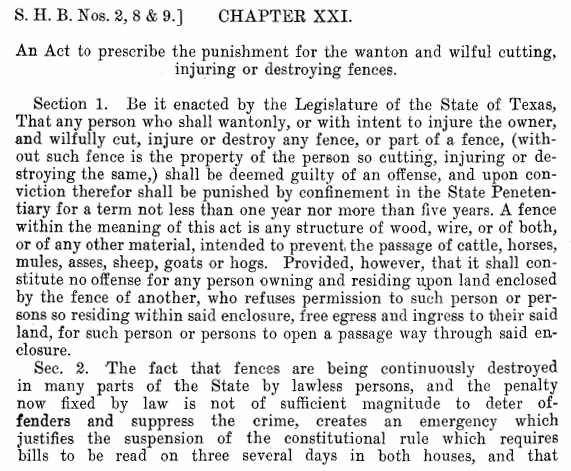
For most of the 1800s, Texas was open range. Then barbed wire came along, and even a trail driver like William H. Day saw the benefits of owning and then fencing off his newly purchased land in Coleman County. His wife, Mabel Doss Day, wrote about his efforts in a September 1879 letter: "Col. Day is building a fence around his pasture, which when done will contain forty thousand acres of land….He has twenty men at work on the fence and it keeps him busy bossing them."[1]
Mabel Day's involvement in the ranch became much more hands-on in 1881, after her husband died from injuries sustained in a stampede. To address debt and other concerns, she reorganized as Day Cattle Ranch Company, sold half-interests in her cattle to investors in Kentucky (while retaining full title to the land), and by 1883, Day Cattle Ranch was the largest fenced ranch in Texas.[2] Mabel Day became known as the "Cattle Queen of Texas."[3]
However, 1883 also saw an extensive drought and with it, the beginning of the fence wars. Cowmen without land struggled to find adequate grass and water on public land, and landowners sometimes were guilty of enclosing public land and roads with their fences. At least three men were killed in fights between fence cutters and ranchmen, and by fall 1883, damage from fence wrecking was estimated at $20 million.[4]
On September 13, 1883—135 years ago this week—the Austin Weekly Statesman noted that wire fence cutting had arrived in Coleman County.[5] Mabel Day was one of the many whose fence suffered. "They cut more than five miles of her fence and tacked a notice on her gate post that if she put the fence back up 'there would be the largest coroner's inquest in that pasture ever held in Texas.'" She did put the fence back up, only to have 10 more miles cut in broad daylight. Even when she sent armed men out to protect her fence, they were outnumbered, and she lost more than 100 miles of fence.[6]
Mabel Day became one of the leading voices in urging the legislature to action. Her letter to the editor of the Coleman Voice was reprinted in several newspapers, including the October 11, 1883, Austin Weekly Statesman: " For my part I think the men (?) who destroyed five miles of my fence last week could have with as much justice burnt my house…. I would like to address a question to the stockmen of this section. Is there no recourse for us in the matter? Should you, as business and law abiding men adopt any plan to protect your property I would beg to considered as one among you."[7]
A few days later on October 15, Gov. John Ireland called a special session of the 18th Legislature to convene in January 1884 and address fourteen topics, including "to consider and provide a remedy for wanton destruction of fences." In his message to the Legislature when they convened, Gov. Ireland casted blame on both the ranch owners and fence cutters. The House Committee on Fence Cutting was formed, several versions of bills to address the matter were introduced, and much debate ensued.
A central point of dispute for the lawmakers was whether punishment should be equal for illegal fence cutting and illegal fence building. In the final January 31 vote on House Bills 2, 8, and 9, Reps. Wortham, Galt, Garrison, and Burns are recorded in the House Journal saying, "We vote "no," because we believe that the punishment for the unlawful fencing of land and the cutting of a fence should be alike—that is to say, if the crime of fence cutting is declared a felony, the unlawful fencing of land should also be declared a felony. To do otherwise will very naturally be construed to mean class legislation, and create widespread dissatisfaction, well calculated to aggravate the evil now afflicting the State."
However, the bills passed in a 71-22 vote. Acts 1884, 18th 1st C.S.,ch. 21, General Laws of Texas, set out punishment for fence cutters; Acts 1884, 18th 1st C.S.,ch. 24, General Laws of Texas, required gateways in every three miles of fencing. Faced with jail time, the fence cutters put down their wire cutters; ranch owners installed gates. Mabel Day married Captain J.C. Lea in 1899 and moved with him to New Mexico, but she continued to oversee her Coleman County ranch. At the time of Mabel's death in 1906, her daughter inherited debt-free (and fenced) land.[8]
Tile image by Flickr user eflon and used under a Creative Commons Attribution Generic license.
[1] "Colonel William H. Day: Texas Ranchman," by James T. Padgitt, The Southwestern Historical Quarterly v. 53, July 1949-April 1950, Texas State Historical Association, Austin, TX (https://texashistory.unt.edu/ark:/67531/metapth101126/, accessed August 27, 2018), University of North Texas Libraries, The Portal to Texas History.
[2] Handbook of Texas Online, Elizabeth Maret, "Lea, Mabel Doss," accessed August 21, 2018, http://www.tshaonline.org/handbook/online/articles/flejr.
[3] Texas Historical Foundation. Texas Heritage, Fall 1984; Austin, Texas. (https://texashistory.unt.edu/ark:/67531/metapth45447/: accessed August 27, 2018), University of North Texas Libraries, The Portal to Texas History.
[4] Handbook of Texas Online, Wayne Gard, "Fence cutting," accessed August 21, 2018, http://www.tshaonline.org/handbook/online/articles/auf01.
[5] "Mrs. Mabel Day and the Fence Cutters," by James T. Padgitt, West Texas Historical Association Year Book, October 1950, https://padgitt.blogspot.com/2012/11/mrs-mabel-day-and-fence-cutters.html, accessed September 5, 2018.
[6] "Fence Cutting War Was Stormy Time," Coleman Democrat-Voice, August 12, 1980, (https://texashistory.unt.edu/ark:/67531/metapth733459/, accessed August 27, 2018), University of North Texas Libraries, The Portal to Texas History.
[7] The Austin Weekly Statesman, v. 13, No. 6, Ed. 1, Thursday, October 11, 1883, (https://texashistory.unt.edu/ark:/67531/metapth277915/: accessed August 29, 2018), University of North Texas Libraries, The Portal to Texas History.
[8] Handbook of Texas Online, Elizabeth Maret, "Lea, Mabel Doss."

